MILLS OF LEITH & the KEDSLIES
Andrew Kedslie (father of Andrew) established a mill in Leith, at first leasing premises at Bonnington and later establishing a steam mill at Stocknridge. Andrew evidently learned his engineering skills there and was to be eniticed to Poland to improve the situation there.
Mills at Leith before Kedslie
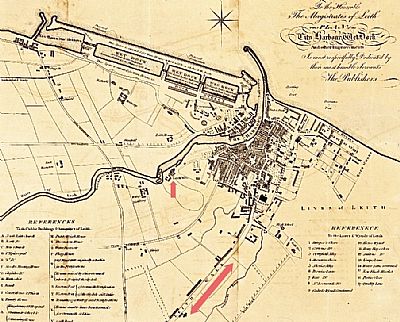
In this map of 1807, Leith is still urban only around the docks, but the main road to the south west, Leith Walk (marked with two ended arrow) has some clusters of housing. What os shown as "Leith Mills" is shown with a simple arrow. This is NOT Bonnington Mill which was a little further to the west.
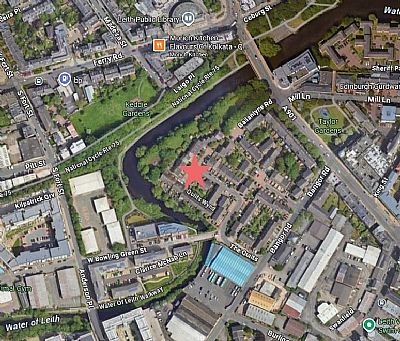
And this is what that area shown with the star in the previous map looks like today. Modern housing with street names such as The Quilts and Ballantyne Road. Google.
I have included the above so that anyone trying to identify the mill Kedslie occupied is not thrown off course. He will have known them, but "his" mill is described below.
Bonnington Mill
The remains of several water powered mills can still be seen on the Water of Leith. However this picturesque scenario is not how Kedslie's mill looked. The Statistical Account of Scotland of 1791 reported that there were seventy-six mills along the Water of Leith. Mcleod notes that the family had rented one of them, the Bonnington Mills.
We have one more step to take before being more specific.
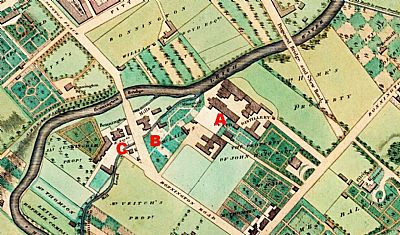
This map is from 1820. It still shows a landscape covered by fairly formally laid out farming estates. Mills and similar enterprises were generally owned by those estates. Here we see a large distillery at "A" with mills on each side of the road which crossed the Water of Leith with a bridge at "B" and "C". To the east of "A" is another bridge shown "proposed". In the following map you will see that bridge as serving the railway (now a road bridge).
We are at last getting closer to what is believed to be Kedslie's mill. Was part of that complex leased from the distillery? The two industries of are not really that dissimilar. Barley is usually used for whiskey, but so can rye and wheat (and corn for bourbon). Our Kedslie was a not only a miller, but a trader in related products.
The Scottish Mills Website (utilising the NLS maps facility) identifies many mills around the Water of Leith and further afield. It records the Bonnington Corn Mill (as opposed to the paper mill) as follows.
Name: Bonnington Corn Mills
Alternative Name: Bonnington Corn Mills
Parish: Edinburgh
County: Edinburgh
On 1st edition maps (1840s-1880s)?: Yes
1st edition classification (1840s-1880s): Flour Mill, Watermill
On 2nd edition maps (1890s-1900s)?: Uncertain
Perhaps the uncertain classification in the next edition of the map signifies the period when it was no longer operating.
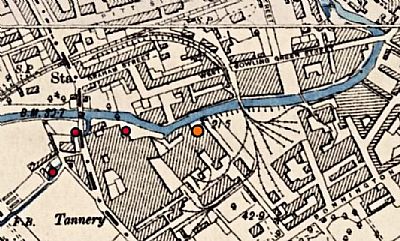 This is an extract from that map on the website. The orange dot to the right is the Bonnington Corn Mill. The nearest red one to the left of it is Bonnington Paper Mill and to the left of that another unidentified water mill. While not specifically dated this map is 1840s-1880s.
This is an extract from that map on the website. The orange dot to the right is the Bonnington Corn Mill. The nearest red one to the left of it is Bonnington Paper Mill and to the left of that another unidentified water mill. While not specifically dated this map is 1840s-1880s.
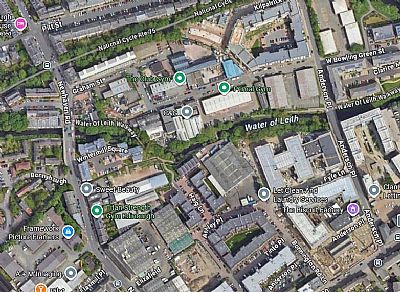
This is what the area looks like today. The Bonnington Mill would have been almost central on this Google map extract, just south of the kink in the Water of Leith. Nothing seems to have survived. However the names of the housing developments around Newhaven Road before it crosses the Water to the immediate west of it do recall the other two mills with "Watermill Square and Boonyhaugh (a variant of Bonnington).
Leaving the water and going steam
Steam meant that mills could be established beyond the limitations of the water flow. Alexander's father Andrew had built a steam mill at Stockbridge between the Water of Leith and the New Town - much to the annoyance of the residents who took him to court. A leading figure in this was the painter Henry Raeburn.
The aforementioned map website makes no mention of this one as it is no longer a water power mill.
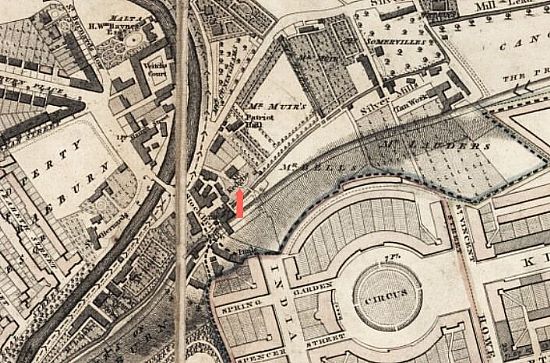
This is an extract from a map by Robert Kirkwood of 1817 from the NLS website. I have marked the Kedslie grain mill just east of Stockbridge itself, with a red arrow. (Note that variations of the name occur in this case "Kedglie"). Henry Raeburn’s property to the left. While west of what is usually considered the New Town and across the Water of Leith and canal, it is evident that Raeburn is a property developer. It is not just his home that was affected, but the sales of the properties. John Lauder’s tannery at Silvermills was also nearby.
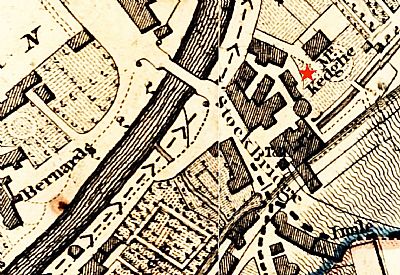
This is the same map; a closer view of the Keglie premises.
Nothing remains of the Stockbridge Mill today except for the lade that supplied it with water and the name of the modern apartment block, Lade Court, that stands on its site in Baker’s Place. Confusingly this is actually now a building in Kerr Street, which leads into Circus Place, EH3 6SY yet very close to the Water of Leith.
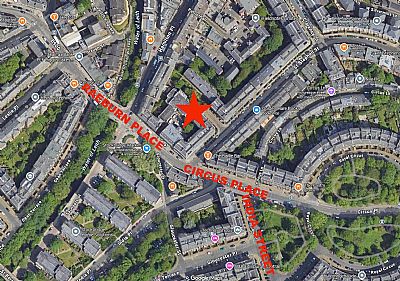
The area as it is today. The star indicates the location of the Stockbridge mill. You can make out the Water of Leith not that far away to the left /west by the line of trees. It is evident though that the area did not develop quite as anticipated. The road through the circus is Circus Place. It continues over the Water of Leith becoming Raeburn Place. India Street though is much as intended.
Greater moves
Again from Mona McLeod : Kedslie was one of a new generation of millers. His family had been small landowners in Lauderdale in the Borders since the twelfth cenutury. His father Andrew, who was a younger son, moved to Leith where he became a corn merchant and miller and a burgess of Edinburgh. Alexander's burgess ticket was issued in 1807 'by right of his father'. By family tradition, Alexander started to study medicine at Edinburgh University and made contact there with Counct Aleksander Ptocki during his firts visit to Scotland in 1803.
Opposition to steam
This link takes you to a fascinating paper by Karen Baston about the case of Henry Raeburn, the famous artist suing Alexander for soot coming across to his house. Alexander won the case. You can find more about that here. http://file:///C:/Users/jerem/Documents/FAMILY%20STORIES/Kedslie%20mill%20vs%20Raeburn%20139857.pdf
But in 1806 Napoleon's Continental System blocked the ports of France and its allies to British trade. Britain retaliated by preventing France from trading with neutral countries. Corn prices in Scotland soared. But Kedslie managed to get through the double blockade by getting two cargoes of Scottish goods into Danzig on the Baltic. The corn that he brought back was sold at Leith when the prices were very high and he did very well out of it. The two years later after Waterloo the blockades were lifted and corn prices sunk. He lost a substantial amount of money.
So when Count Potocki invited him to manage the steam mill at Solec at Warsaw he jumped at the opportunity.
Life there seems to have got off to a good start. The Kedslies were just one of many families that settled there. Our Watsons included. The promising circumstances that earlier immigrants had found was beinging to wane.
The case of Alexander Kedslie is worth quoting as an example of the type of harassment to which British citizens were being subjected. Kedslie, an engineer and miller from Edinburgh, had come out in 1829 to manage the Warsaw steam mill for Prince Potocki. In 1835 he rented Rosancie, a farm on the Zamoyski estate on the border of Austrian Galacia. In June 1838, writing from Warsaw, he complained to the consul about the seizure of papers by officials who refused to show any authorisation for their actions.
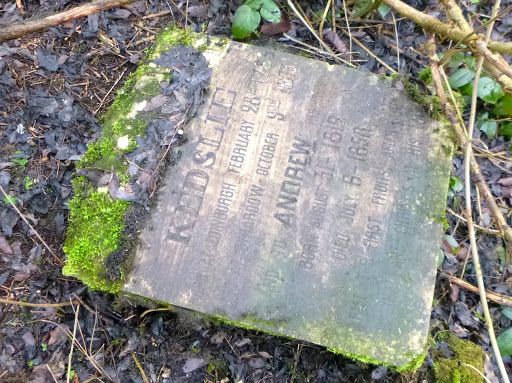
This is the gravestone of both Alexander Kedslie and his son Andrew. It lies scattered with others and overgrown. I found this online while randomly using Google Images to find illustrations. It comes, not from a history or geneaology website, but one on cycling. The name of Alexander is almost hidden, but the photographer identifies it and other details. I am grateful to him for giving permission to use it here. Tomasz Kuran - meteor2017. He wonders : The most interesting gravestone is this one, subtitles in English, Alexander Kedslie, born in Edinburgh, died in Zyrardów. It seems that the Scot - in fact, along with other nations that could be found in Zyrardów, also the Scots were mentioned ... since he came to Zyrk from such a distance, he probably occupied a high position in the factory, who knows maybe he lived in palaces, and the tombstone looks better. And why the grave in Wiskitki, and not in Zyrardów? Because back then there were no churches or cemeteries in Zyrardów.
Alexander Scott Watson had had similar treatment with regard to travel documents and it was presumably a common experience for all immigrants. While they had arrived with very favourable terms, the politics had changed considerably. As Poland was rearranged and became a puppet state of Russia, there was both hindrance and intimidation.
PERSPECTIVE
My New Zealand family contact provides the following which gives better perspective of who is who. Water of Leith and Stockbridge to the west of it were beyond the New Town of Edinburgh (and nwo absorbed by it). Although both families were millers and their eras seemingly concurrent, we need to differentiate between them something that needs further research.
With regards to: Alexander and Jane Kedslie.
Our Agnes m to Alexander Scott Watson bap. 12 Jan. 1805 was actually the sister of Alexander. They were both part of a large family born to Andrew Kedslie and Agnes Thomson all from Stockbridge .
Our Agnes was 70 when she died in Plymouth in 1870.
There was also another Alexander Kedslie married to a Catherine in the same area.
Agnes Stevenson was the daughter of Alison, another sister. The Agnes who kept on working was Alexander's daughter.
Also see : https://www.myheritage.com/names/john_kedslie
POSTCRIPT
In doing research on Scotland's People for this I came across a death register which has the name of a Alexander Kedslie, a child :
5th August 1841.
Alexander Kedslie Son of ? Alexr Kedslie 1yr 7mnths 9 Deanhaugh Street Stockbridge Fever.
What is striking is that of the 25 names on this page (July and August) 18 were children. Reasons for death of these children include Fever for little Alexander to Scarlet Fever, Measles, Dropsy, Decline, Water in the Head and Disease of the Spine.
Deanhaugh Street is now an alley near the Water of Leith and possibly then to do with the mill that Alexander senior was connected with before going to Poland. This gives credence to the suposition that this person was connected to our our known family member. Health condition were directly tied to living conditions. Edinburgh in 1841 was at the point of tremendous improvements, but even if his family was poor and had limited dietry range and quality, simply living in proximity to those with such problems increased the risk of them too.
Bonnington Mill remains : https://en.wikipedia.org/wiki/Bonnington,_Edinburgh ; https://canmore.org.uk/site/148282/edinburgh-newhaven-road-bonnington-mills-granary and https://www.geograph.org.uk/photo/2828367
Graves in Poland: Besides the reference by the person who took the picture of the gravestone depicted above is this reference https://genealodzy.pl/PNphpBB2-printview-t-17451-start-0.phtml Not much detail, but we can note that local people are taking an interest. Wikipedia gives more detail of the cemetry itself and names both Alexander and Andrew. https://pl.m.wikipedia.org/wiki/Cmentarz_protestancki_w_Wiskitkach
NAITONAL LIBRARY OF SCOTLAND : NLS MAPS : https://maps.nls.uk/towns/rec/2713
Kirkwood 1817 : https://maps.nls.uk/view/74400073
THE SCOTTISH WATER MILLS WEBSITE : https://maps.nls.uk/projects/mills/#zoom=16&lat=55.9716&lon=-3.1831
TAYLOR MAXWELL on Bonnington Mill : https://threadinburgh.scot/2022/10/24/the-thread-about-bonnington-its-early-history-where-its-name-comes-from-which-bonnington-house-is-which-and-a-little-bit-of-its-early-industries/
ROY THOMPSON on Bonnington Historical Background : https://blogs.ed.ac.uk/roythompson/wp-content/uploads/sites/566/2024/09/Bonnington_Historical_Notes.pdf

